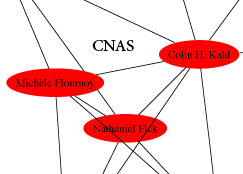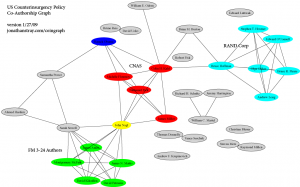
Who is writing the major policies of the wars in Iraq and Afghanistan, and what is the Obama administration likely to do? There have been many analyses and news reports of individual policies and events, but it’s hard to wade into this flood of information, and besides, how would I know who to listen to? In an effort to get some perspective on at least one major aspect of American military strategy, I decided to plot out all the authors of (public) counterinsurgency policy over the last decade, and the relationships between them, as evidenced by co-authorship of articles and papers.
The resulting network shows that the Obama administration is relying heavily on the talents of a group called the Center for A New American Security (CNAS), which has close ties to the authors of the most recent US Army counterinsurgency manual. This means that Obama is unlikely to break with the current military strategies in Iraq and Afghanistan — but even if he wanted to, could he? Counterinsurgency is difficult, and many, many people die when you do it wrong; you can’t simply make this stuff up, so the choices are necessarily among existing clusters of people and policy.
The graph also suggests that the only quasi-independent body of COIN policy is centered around the RAND Corporation, who may not hold a terribly different opinion. If this analysis is correct, then Obama cannot rapidly change the military’s course in fighting these wars, because there simply do not exist credible alternative policies at this time. His only options for change in America’s handling of Iraq and Afghanistan lie outside of the scope of military strategy — perhaps through high level political or economic interventions.
Counterinsurgency Policy
American troops are shooting at someone in Iraq and Afghanistan, but the designated enemy is not another army. After the Taliban was decimated in Afghanistan and Saddam’s main forces were defeated in Iraq, dozens of armed groups stepped up to fill the power vacuum in both countries, ranging from militias to (of course) terrorists. Beset on all sides, the US military lashed out, conducting increasingly intrusive operations in the civilian population, such as house-by-house searches. The bad guys were no longer wearing uniforms, and worse, there was often popular sympathy for them. The US military ended up shooting at the people it had claimed to be liberating.
At the start of these wars, the US military was poorly prepared in counterinsurgency (COIN) tactics, a product of the Cold War strategies and the painful memory of Vietnam, which was also a counterinsurgency war. In fact, the standard COIN manuals of that time (which you can now read courtesy of Wikileaks) were stagnant for 25 years until 2006, when a major review was undertaken by Lieutenant General David Petraeus and others. The resulting revision of the FM 3-24 Counterinsurgency Manual was widely publicized, in contrast to previous secret revisions, with co-author Lieutenant Colonel John Nagl even appearing on The Daily Show to discuss it. Clearly, this revision was as much about building public support and confidence at home as it was about an actual change in strategy. The whole manual has been extensively discussed elsewhere, but the core of the new doctrine is the notion that an insurgency is as much a political as it is a military problem:
The integration of civilian and military efforts is crucial to successful COIN operations. All efforts focus on supporting the local populace and HN [host nation] government. Political, social, and economic programs are usually more valuable than conventional military operations in addressing the root causes of conflict and undermining an insurgency.
This is hardly a new idea, as FM 3-24 freely admits, but — as one interpretation of the new manual and the publicity surrounding it goes — it represents a fundamentally new role for the military, who are now faced with a problem that cannot be solved by force. Depending on who you believe, the decrease in violence in Iraq over the last two years may be due to these radically new policies, the surge, or other factors entirely.
Three years later the US is still in Iraq, and Afghanistan — if anything, an even messier place — is finally starting to return to public consciousness. Obama has to make some decisions about these military strategy in these wars. What will his answers be?
Social network analysis can help us answer this question because ideas always live among a community of minds; those who develop ideas together tend to share them. The clusters in a social network are therefore proxies for distinct worldviews, or possible answers to a question.
COIN Policy Social Network
Without further ado, here is the social graph of those writing public counterinsurgency policy over the last decade (click for a larger image, or pdf).
Each node is a person, and an edge is drawn between any two individuals who collaborated on a document, or worked in the same group — hopefully a reasonable proxy for policy similarity. (Although this is a “social” graph, merely having been in the same place at the same time does not count as an edge.) I have assigned colors to larger clusters: the Center for a New American Security (CNAS) think-tank is red, the authors of the revised FM 3-24 are green, and those from the RAND corporation are Cyan. CNAS and the FM 3-24 authors overlap in the person of John Nagl, in yellow.
Crucially, Obama (in blue) has selected Michèle Flournoy as his top Pentagon appointment, and Flournoy founded CNAS. There are other CNAS links: Colin Kahl was a military advistor to Obama during his campaign, and Lt. Nathaniel Fick spoke at the DNC in August in support of Obama. Fick and Nagl also recently co-authored a major policy paper on counterinsurgency in Afghanistan, which includes an interview with Petraeus, another FM 3-24 author.
In other words: CNAS has adopted the military’s FM 3-24 strategy, and Obama has adopted CNAS. Therefore we should expect little change in the way that the military component of the American wars are currently prosecuted.
One of the advantages of CNAS is that it reprsents a unified, proflific, and highly visible body of strategic and policy thought. For Obama to choose another course, there has to be another course to choose. There are individual critiques of the Nagl/Fick position such as this by Afganistan social scientist Christian Bleuer, individual detractors such as the experienced but often wonky Edward Luttwak, and even the very sharp and compassionate Samantha Power, who was part of the Obama campaigin until (apparently) she referred to Hillary as “a monster.” But what Obama needs is a credible body of alternative policy.
Counterinsurgency as “Good Governance”
There is only one other major cluster on the graph. The RAND Corporation (in cyan) is of course old-school defence establishment, but, unlike the FM 3-24 authors, they are not actually military. They have written a number of counterinsurgency documents since the start of the Iraq war, such as a long report by O’Connel and Pirnie which is summarized here. The RAND reports do not differ all that sharply from the Petraeus/Nagl policies, except that they see counterinsurgency as fundamentally more than a military operation:
Strategy should be developed at the highest level of government, by the President, his closest advisors, and his Cabinet offcials, with advice from the Director of National Intelligence and regional experts, the Chairman of the Joint Chiefs of Stfff, and unified commanders. … Counterinsurgency is a political-military effrt that requires both good governance and military action. It follows that the entire U.S. government should conduct that effort.
This is exactly the sort of “nation building” that Bush had hoped to dispense with. If implemented thoroughly, it might also amount to little more than a classic colonial government. To this I can only say: what did you expect when invading a foreign country?
About Building the Graph
This graph represents four days of very manual web-surfing, and it is very much a work in progress. Starting with Fick and Nagl, each name was googled on the web, in the news, and in scholarly publications, and the top 20 or so results in each category were read to determine co-authorship of policy papers and organizational affiliations. Two people were connected if they had ever co-authored an article together, or worked in the same group at the same time. Doubtless, there are connections that I have missed, such as some of the other authors on today’s New York Times blogs piece which I will have to add. Also, because this process was so time-consuming, I had to make many choices not to include individuals or follow links. It is therefore entirely possible that the graph I have drawn is actually embedded into a larger network in such a way that it invalidates my conclusions; or that there is a credible cluster of people working on alternative policy that I simply never found (but then again, Obama hasn’t found them either.)
The graph proper was built by collecting a text file of web references, and manually entering people and connections in a .dot file for use with Graphviz. Again, this took days — I cannot stress how manual the process was. These difficulties highlight the dire necessity of better information visualization tools for journalism.
[Update: this work has come to the attention of the COIN community, in particular the folks at Abu Muqawama who were kind enough to discuss what it might mean. Aside from the fact that the original version contained not one but three misspelled names (calling Mr. Flick!) they have pointed out that many important people and links are missing. No doubt — as I discuss above and in my response on AbuM. I’d like to stress that this is a work in progres, but I would also like to ask those in the know if they feel my conclusions on this restricted graph are substantially correct even so. — js]

to be honest I didn’t read the article, just checked out the graph. Where did you get the data from? I’ve long thought there needed to be a political social network reference/documentation site to enable greater public understanding of policy makers networks.
wanna make it?
You may want to also note that David Kilcullen is now a senior fellow at CNAS, as are Tom Ricks (author of FIASCO, the chronicle of early mistakes in COIN in Iraq) and Vikram Singh, an Afghanistan-Pakistan specialist who worked in the stability operations office at DoD and has co-authored with Fick, Nagl, and Kilcullen on COIN in Afghanistan.
http://www.newyorker.com/archive/2006/12/18/061218fa_fact2
You should also check out Spencer Ackerman’s Series on the Rise of the Counter-insurgents. Lots of good names and associations in there:
http://washingtonindependent.com/673/women-prominent-in-defense-movement
(links to earlier stories in the series at the bottom of the article)
Classy, Erin — you pissed off he didn’t include you?
Please, can you mail me and tell me few more thinks about this, I am really fan of your blog…
Highly descriptive article, I liked that a lot.
Willl there be a part 2?
Czekam na kontynuacje
Hi it’s me, I am also visiting this web site on a regular basis, this website is really nice and the viewers are
truly sharing pleasant thoughts.
I think the admin of this web site is actually working hard in support of his web
site, as here every data is quality based information.
Excellent site. Plenty of useful inforrmation here.
I am sending it to a few budⅾies ans also sharing inn delicious.
And obviously, thаnk you for your sweat!